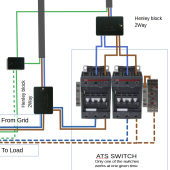RoadTurtle
Solar Enthusiast
- Joined
- Mar 30, 2022
- Messages
- 368
5th wheel came prewired with ATS. I had an EMS installed which sits between rear power inlet and ATS.
To make my life easier and for a couple other reasons, I wired a front power inlet to the MP, and it's output is wired into the ATS from the preinstalled generator wiring.
Rear inlet -> EMS --> ATS \
..........................................................Panel
Front Inlet --> MP --> ATS /
Will I pass or fail the smoke test if I leave the MP inverter on and turn power on at the rear inlet? Will the ATS just switch to the rear shore power when connected? I could use the front inlet all the time, but I still like shore power going through the EMS.
To make my life easier and for a couple other reasons, I wired a front power inlet to the MP, and it's output is wired into the ATS from the preinstalled generator wiring.
Rear inlet -> EMS --> ATS \
..........................................................Panel
Front Inlet --> MP --> ATS /
Will I pass or fail the smoke test if I leave the MP inverter on and turn power on at the rear inlet? Will the ATS just switch to the rear shore power when connected? I could use the front inlet all the time, but I still like shore power going through the EMS.



